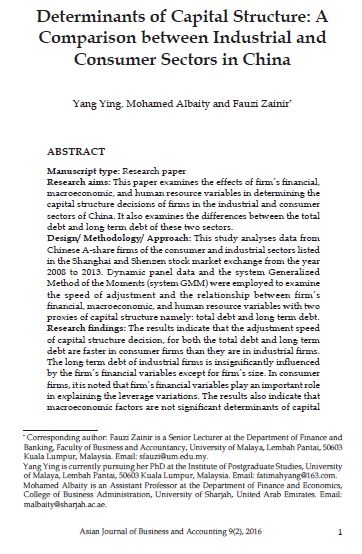Determinants of Capital Structure: A Comparison between Industrial and Consumer Sectors in China
Main Article Content
Abstract
Manuscript type: Research paper
Research aims: This paper examines the effects of firm’s financial,
macroeconomic, and human resource variables in determining the
capital structure decisions of firms in the industrial and consumer
sectors of China. It also examines the differences between the total
debt and long term debt of these two sectors.
Design/ Methodology/ Approach: This study analyses data from
Chinese A-share firms of the consumer and industrial sectors listed
in the Shanghai and Shenzen stock market exchange from the year
2008 to 2013. Dynamic panel data and the system Generalized
Method of the Moments (system GMM) were employed to examine
the speed of adjustment and the relationship between firm’s
financial, macroeconomic, and human resource variables with two
proxies of capital structure namely: total debt and long term debt.
Research findings: The results indicate that the adjustment speed
of capital structure decision, for both the total debt and long term
debt are faster in consumer firms than they are in industrial firms.
The long term debt of industrial firms is insignificantly influenced
by the firm’s financial variables except for firm’s size. In consumer
firms, it is noted that firm’s financial variables play an important role
in explaining the leverage variations. The results also indicate that
macroeconomic factors are not significant determinants of capital structure decisions, especially for industrial firms. In addition,
employment size and employment in industry have significant
positive impact on total debt in consumer firms while employment
size and employment productivity have a negative influence on
the long term debt in industrial firms. Lastly, there is a significant
difference between consumer firms and industrial firms, in term of
the type of debt they carry.
Theoretical contributions/ Originality: This study expands on
previous work done on indirect effects of sectorial and industry
level factors on the relationship between leverage and firm’s specific
determinants of capital structure, in developing economies. It
extends the applicability of capital structure theories that are highly
dependent on the types of leverage despite sector behavioural issues.
Practitioner/ Policy implications: This paper provides insights
on the variables which explain the level and types of leverage of
Chinese firms in both the consumer and industrial sectors.
Research limitations/ Implications: Future studies should consider
other proxies for capital structures such as market value of total,
long and short term debts. Future studies should also investigate
firms in other sectors.
Keyword: Adjustment Speed, China, Consumer Firms, Dynamic
Capital Structure, Industrial Firms
JEL: G00, G32, G39
